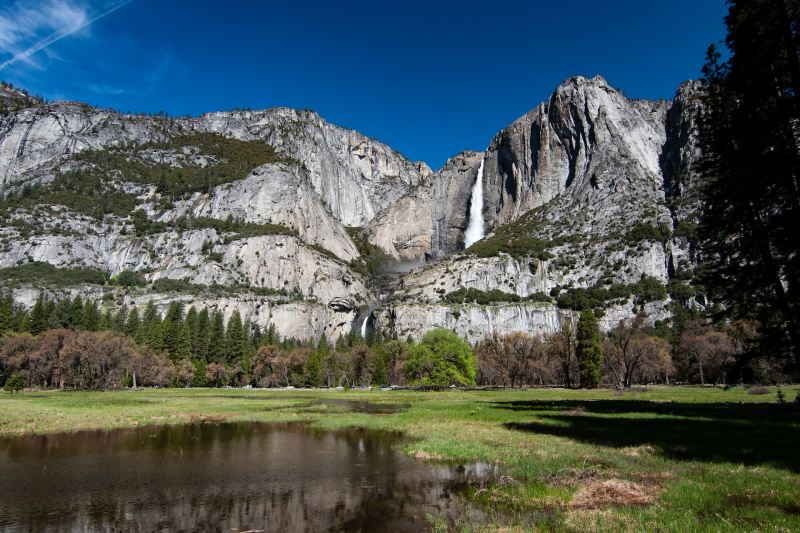If you’ve only got enough PTO for one trip this year, there’s a chance you might be juggling between Yosemite and Yellowstone. It’s tough to narrow down the options, but we’ve compiled some of the greatest experiences from each park to help you make the decision.
In this article, we’ll take a look at each park and compare and contrast the two. Without further ado, here’s Yellowstone vs. Yosemite.
Here’s why Yellowstone National Park is so special

Yellowstone National Park was established in 1872 as the very first national park. This stunning part of the country sprawls across three states: Wyoming, Montana, and Idaho. Covering 2.2 million acres, it’s famous for its geothermal geysers, abundant wildlife, and numerous activities. Here’s why everyone loves it.
Geothermal geysers
Yellowstone is home to over 10,000 hydrothermal features, including more than 500 geysers. The star of the show is Old Faithful, a geyser famous for its predictable eruptions. Besides geysers, the park has fumaroles and mud pots, as well as many multicolored hot springs like Mammoth Hot Springs.
An abundance of wildlife
Yellowstone’s ecosystem is a sanctuary for a diverse array of wildlife. It’s actually home to the largest wild bison population in the U.S., and you can usually find them in the Lamar and Hayden Valleys. You’ll also see elk, wolves, moose, and even bears. Just make sure you stay far away from them.
Activities at Yellowstone
There’s a ton to do at Yellowstone, so consider planning a multiday trip to see it all. There are 12 campgrounds with over 2,000 sites, so you’ll have plenty of options. Popular campgrounds include Madison Campground, Giant Village Campground, and Canyon Campground. There are also backcountry camping options for those who are super adventurous.
There are also 900 miles of hiking trails that range from short walks to challenging hikes. If you’re looking for something easy, try Mystic Falls (2.5 miles), Fairy Falls (5 miles), or Lone Star Geyser (4.8 miles). For something more moderate, try Mount Washburn Trail (6 miles roundtrip), which has great views of the park. Advanced hikers will appreciate challenging hikes like Avalanche Peak (4.2 miles) and Electric Peak (16 miles).
For those who are into scenic drives, check out the Grand Loop Road, which hits all the major sights. Beartooth Highway is another great option, but if you want to drive through a thermal area, try Firehole Lake Drive.
You will also find plenty of fishing and boating opportunities, but you’ll need permits for those. Horse lovers will enjoy horseback riding trips through Yellowstone’s horseback riding tours. Or, come back in the winter for snowmobiling, cross-country skiing, and snowshoeing.
Everything you need to know about Yosemite National Park

In contrast, Yosemite National Park is predominantly in California’s Sierra Nevada mountains, which covers nearly 750,000 acres. It became a national park in 1890, largely thanks to the efforts of naturalist John Muir. Here’s what it has to offer.
Granite cliffs
Yosemite’s claim to fame is its breathtaking granite cliffs. Towering monoliths like El Capitan and Half Dome are not just sights to behold but also meccas for rock climbers worldwide. These formations are products of glacial activity, sculpting the valley into sheer cliffs and unique rock formations.
Waterfalls and sequoias
The park is renowned for its stunning waterfalls, particularly Yosemite Falls, which is one of the tallest in the world. Although summer often sees a reduction in water flow, the sight of these falls is still awe-inspiring. Additionally, Yosemite is home to ancient giant sequoias that reside in tranquil groves.
Activities at Yosemite
Yosemite has a total of 13 campgrounds, with reserved and first-come, first-served sites. Many popular campgrounds include Upper Pines, North Pines, and Lower Pines. All three have great access to the park’s main attractions. But for those seeking some solitude, they also offer trails for backcountry
This national park also has extensive
If you’re into rock climbing, Yosemite has you covered. Known as one of the best rock climbing places in the world, there are too many climbing and bouldering locations to count. Favorites include El Capitan, which has challenging vertical routes. If that’s not your thing, you can also try bouldering near Camp 4.
Some of the best scenic drives include Glacier Point Road, which takes you by some of the most iconic views of Yosemite Valley, Half Dome, and numerous waterfalls along the way. Tioga Road runs right across Yosemite’s high country, taking you through sweeping views of alpine meadows, lakes, and the Sierra Nevada mountains. Wawona Road is famous for the Mariposa Grove, which is a forest of sequoias.
Yosemite has great activities year-round. It offers horseback riding, rafting and swimming, stargazing, and several winter activities like snowshoeing, cross-country skiing, ice skating, and downhill skiing and snowboarding at the Badger Pass Ski Area.
Yellowstone vs. Yosemite

When comparing Yellowstone and Yosemite, the choice boils down to your personal preferences and interests. If geothermal phenomena and a broader range of wildlife interest you, pack your bags for Yellowstone. However, if you’re captivated by majestic rock formations, waterfalls, and giant sequoia trees, Yosemite will not disappoint.
Yellowstone’s sheer size means more ground to cover and a wider variety of ecosystems to explore. Yosemite, while smaller, offers a more concentrated experience with its iconic landmarks. Here’s a look into what it might cost to visit:
Travel costs
Yellowstone is located in Wyoming, Montana, and Idaho and may be more remote, depending on your starting point. Yosemite is in California’s Sierra Nevada, which is closer to major airports. Consider the cost of getting to these parks from your location, including flights, car rentals, and fuel.
Entrance fees
Both parks charge entrance fees. Yellowstone’s entrance fee for a private, non-commercial vehicle is about $35, according to the National Park Service. Yosemite has a similar fee structure, but it may require a reservation depending on what time of the year you go. Prices are subject to change, so it’s recommended that you check the current fees.
If you plan to visit multiple national parks or return within a year, the America the Beautiful Pass could be a cost-effective option at $80, covering entry to all federal recreational lands.
Accommodations
Both parks offer a range of accommodations inside the perimeter, from campsites to lodges. Prices can vary widely, with lodges typically being more expensive. Booking well in advance is crucial, especially during peak seasons. To avoid this, you may want to consider staying in nearby towns for potentially cheaper options, but factor in the travel time and costs to enter the park each day.
Whether you’re drawn to the geysers and wildlife of Yellowstone or the granite peaks and waterfalls of Yosemite, both parks promise an encounter with America’s wild side.




